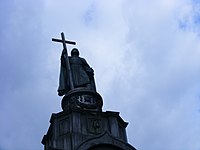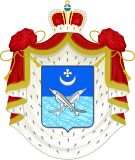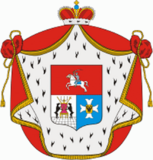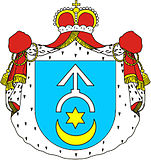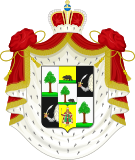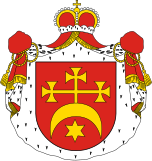Rurikids
| Rurikids | |
|---|---|
 Personal seal ofYaroslav the Wise | |
| Country | |
| Founded | 862(inNovgorod) |
| Founder | Rurik |
| Final ruler | Feodor I of Russia Vasili IV of Russia(junior branch) |
| Titles |
Princely titles |
| Style(s) | |
| Estate(s) |
|
| Deposition | 1610(in Moscow,Tsardom of Russia |
| Cadet branches |
|
TheRurik dynasty,[a]also known as theRurikidorRiurikid dynasty,as well as simplyRurikidsorRiurikids,[1]was a noble lineage allegedly founded by theVarangianprinceRurik,who, according to tradition, established himself atNovgorodin the year 862.[2][3][4]The Rurikids were the rulingdynastyofKievan Rus'and its principalities following itsdisintegration.
TheRomanovichiruled the southwestern territories, which were unified byRoman the Greatand his sonDaniel,who was in 1253 crowned byPope Innocent IVas theking of Ruthenia.[5]Galicia–Volhyniawas eventually annexed byPolandandLithuania.The northern and northeastern territories were unified by theDaniilovichiofMoscow;[6]by the 15th century,Ivan IIIthrew off the control of theGolden Hordeand assumed the title of sovereign of all Russia.[7][8][9][10]Ivan IVwas crowned as thetsarof all Russia,[11][12]where the Rurik line ruled until 1598, following which they were eventually succeeded by theHouse of Romanov.[13]
As a ruling house, the Rurikids held their own for a total of 21 generations in male-line succession, from Rurik (d. 879) toFeodor I of Russia(d. 1598), a period of more than 700 years.[14][15]Numerousprincely familieshave claimed to trace their lineage to Rurik. They are one of Europe's oldest royal houses, with numerous existingcadet branches.
Origins
[edit]Genealogical issues
[edit]The origins of the Rurikids are unclear, as its namesakeRurik,aVarangianprince who allegedly founded the dynasty in 862 through the "Calling of the Varangians",is considered to be a legendary, mythical and perhaps even entirely fictional character by modern scholars.[b]Nicholas V. Riasanovsky(1947) stated: '...no Kievan sources anterior to thePrimary Chronicle(early twelfth century), knew of Riurik. In tracing the ancestry of Kievan princes they usually stopped withIgor.'[18]As an example,Hilarion of Kiev'sSermon on Law and Grace(1050s), praisingVolodimer I of Kiev,only goes back to his fatherSviatoslav Iand grandfather Igor of Kiev.[19]Even if Rurik did exist, scholars have long doubted or rejected hispaternityof Igor.[c]The connections between Rurik,Olegand Igor, as attested in thePrimary ChronicleandNovgorod First Chronicle,are tenuous at best; in all other cases, these two chronicles base any particular ruler'slegitimacyon the fact that their father or grandfather previously "sat on the throne in Kiev", and never refer back to Rurik.[21]Legitimacy in theKievan Chronicleis also heavily based on a ruler being descended from his father and grandfather, with the exception of two 5-generation lists.[d]Before the mid-15th century, no historical source claims that Rurik founded a dynasty;[24]theHypatian Codexofc.1425 began its list ofknyaziof Kiev with "Dir and Askold", then "Oleg", then "Igor", up to 1240, and does not mention Rurik anywhere.[25]It was not until the 16th century that Rus' churchmen developed an explicit tradition,[24]described in the 1560Book of Royal DegreesbyMacarius, Metropolitan of Moscow,according to which the reigningDanilovichihouse of theGrand Duchy of Moscow(Muscovy) was part of a "Rurikid dynasty", which not only traced back all the way to the legendary Rurik, but was purportedly descended from a certain Prus, a supposed kinsman ofAugustus Caesar.[24]According Ostrowski (2018), the Rus' churchmen developed this concept of a R(i)urikid dynasty for the purpose of "bolstering the Muscovite dynastic state".[26]Although many later historians would accept the 16th-century Rus' churchmen's dynastic claim that the Danilovichi were descended from Rurik, they did not accept Prus as the ancestor of the Muscovite princes.[1]Because of these issues, various scholars have instead named the dynasty theVolodimerovichi,descendants of grand princeVolodimer I of Kiev.[27][16]
Ethnographic issues
[edit]The scholarly consensus[28]is that theRus' peopleoriginated in what is currently coastaleastern Swedenaround the eighth century and that their name has the same origin asRoslageninSweden(with the older name beingRoden).[29][30][31]
According to the prevalent theory, the nameRus',like the Proto-Finnic name for Sweden (*Ruotsi), is derived from anOld Norseterm for "the men who row" (rods-) as rowing was the main method of navigating the rivers of Eastern Europe, and that it could be linked to the Swedish coastal area ofRoslagen(Rus-law) orRoden,as it was known in earlier times.[32][33]The nameRus'would then have the same origin as theFinnishandEstoniannames for Sweden:RuotsiandRootsi.[33][34]
ThePrimary Chroniclegives the following account the "Calling of the Varangians",dating it to the Byzantineyears of the world6368–6370 (AD 860–862):[35]
The tributaries of theVarangiansdrove them back beyond the sea and, refusing them further tribute, set out to govern themselves. There was no law among them, but tribe rose against tribe. Discord thus ensued among them, and they began to war one against another. They said to themselves, "Let us seek a prince who may rule over us and judge us according to the Law." They accordingly went overseas to the Varangian Russes: these particular Varangians were known as Russes, just as some are called Swedes, and others Normans, English, and Gotlanders, for they were thus named. TheChuds,the Slavs, theKrivichians,and theVes'then said to the people of Rus', "Our land is great and rich, but there is no order in it. Come to rule and reign over us." They thus selected three brothers, with their kinsfolk, who took with them all the Russes and migrated. The oldest, Rurik, located himself inNovgorod;the second,Sineus,atBeloozero;and the third,Truvor,inIzborsk.On account of these Varangians, the district of Novgorod became known as the land of Rus'. The present inhabitants of Novgorod are descended from the Varangian race, but aforetime they were Slavs [преже бо бѣша Словѣни].
There is some ambiguity even in thePrimary Chronicleabout the specifics of the story, "hence their paradoxical statement 'the people of Novgorod are of Varangian stock, for formerly they were Slovenes.'"However, archaeological evidence such as"Frankishswords, a sword chape and a tortoiseshell brooch "in the area suggest that there was, in fact, a Scandinavian population during the tenth century at the latest.[36]
Genetic studies
[edit]A genetic study on the origins of Rurikids (Zhur et al. 2023) analysed "for the first time", remains belonging to PrinceDmitry Alexandrovich.The study found that Dmitry Alexandrovich and most of the "medieval and modern Rurikids", starting with PrinceYaroslav the Wise,belong to paternal haplogroupN-M231 (N1a).The genetic results suggest that the formation of the Rurikid lineage included a population from easternScandinavia(Öland), a population fromCentral Europeor theIron AgeEurasian Steppe, and anEast Asiancomponent via Siberian geneflow to Northeastern Europe.[37]
History
[edit]
Rurik and his brothers founded a state that later historians calledKievan Rus′.By the middle of the twelfth century, Kievan Rus′ had dissolved into independentprincipalities,each ruled by a different branch of the Rurikid house. The dynasty followedagnatic seniorityand theizgoiprinciple. The house underwent a major schism after the death ofYaroslav the Wisein 1054, dividing into three branches on the basis of descent from three successive rulingGrand Princes:Iziaslav(1024–1078),Sviatoslav(1027–1076), andVsevolod(1030–1093). In addition, a line of Polotsk princes assimilated themselves with the princes ofLithuania.In the 10th century theCouncil of Liubechmade some amendments to a succession rule and dividedRutheniainto several autonomous principalities that had equal rights to obtain the Kievan throne.[citation needed]
Vsevolod's line eventually became better known as theMonomakhovichiand was the predominant one. The line of Sviatoslav later became known as Olegovychi and often laid claim to the lands ofChernihivandSeveria.The Izyaslavychi who ruledTurovandVolhyniawere eventually replaced by a Monomakhovychi branch.[citation needed]
According to Jaroslav Pelenski,
The 'Riurikide' dynasty and the ruling elite... attempted to impose on their highly diverse polity the integrative concept ofrusskaia zemlia('the Rus' land') and the unifying notion of a 'Rus' people'.... But 'Kievan Rus''was never really a unified polity. It was a loosely bound, ill-defined, and heterogeneous conglomeration of lands and cities inhabited by tribes and population groups whose loyalties were primarily territorial.[39]
This caused the Rurikid house to effectively dissolve into several sub-dynasties ruling smaller states in the 10th and 11th centuries. These were theOlgovichesofSeveriawho ruled inChernigov,Yuryevicheswho controlledVladimir-Suzdal,andRomanovichesinGalicia-Volhynia.[39][40]
Descendants of Sviatoslav II of Kiev
[edit]TheOlgovichesdescended fromOleg I of Chernigov,a son ofSviatoslav II of Kievand grandson of Yaroslav the Wise. They continued to rule until the early 14th century when they were torn apart by the emergingGrand Duchy of LithuaniaandGrand Duchy of Moscow.The line continued through Oleg's sonVsevolod II of Kiev,grandsonSviatoslav III of Kiev,great-grandsonVsevolod IV of Kievand great-great-grandsonMichael of Chernigov,from whose sons the extant lines of the Olegoviches are descended, including the Massalsky, Gorchakov, Baryatinsky, Volkonsky and Obolensky, including Repnin.[citation needed]
Descendants of Vsevolod I of Kiev
[edit]Vsevolod I of Kievwas the father ofVladimir II Monomakh,giving rise to the nameMonomakhfor his progeny. Two of Vladimir II's sons wereMstislav I of KievandYuri Dolgorukiy.
TheRomanoviches(Izyaslavichi of Volhynia) were the line ofRoman the Great,descended from Mstislav I of Kiev through his sonIziaslav II of Kievand his grandsonMstislav II of Kiev,father of Roman the Great. The older Monomakhovychi line that ruled thePrincipality of Volhyniawere eventually crowned kings of Galicia and Volhynia and ruled until 1323. The Romanovychi displaced the older line of Izyaslavychi from Turov and Volhynia as well as Rostyslavychi from Galicia. The last were two brothers of Romanovychi,AndrewandLev II,who ruled jointly and were slain trying to repelMongolincursions. The Polish king,Władysław I the Elbow-high,in his letter to the Pope wrote with regret: "The two lastRutheniankings, that had been firm shields for Poland from the Tatars, left this world and after their death Poland is directly under Tatar threat. "Losing their leadership role, the Rurikids, however, continued to play a vital role in theGrand Duchy of Lithuaniaand the laterPolish–Lithuanian Commonwealth.Most notably, theOstrogski familyheld the title ofGrand Hetman of Lithuaniaand strove to preserve theRuthenian languageandEastern Orthodoxyin this part of Europe. It is thought that the Drutsk and related princely families may also descend from Roman the Great.[citation needed]
TheRostislavicheswere the line ofRostislav I of Kiev,another son of Mstislav I of Kiev, who wasPrince of Smolenskand a progenitor of the lines descending from the princes of Smolensk and Yaroslavl.[citation needed]
TheShakhovskoyswere founded by Konstantin "Shakh" Glebovich, Prince ofYaroslavl,and traces its lineage toRostislav I of Kievthrough his sonDavyd Rostislavich.This branch also descendscognaticallyofIvan I of Moscow,through the latter's daughter Evdokia Ivanovna Moskovskaya (1314–1342),[41][full citation needed]who marriedVasili Mikhailovich,Prince ofYaroslavl(died 1345).[42]They were the great-grandparents of Andrey and Yuriy, the first Shakhovskoy princes. This is possibly the most senior extant branch of the Rurikids, with many Shakhovskoys living outside of Russia after having fled during theRussian Revolution.[citation needed]
TheYuryevicheswere founded byYuriy Dolgorukiy,the founder of Moscow and spread vastly in the north-east. Yuri's sonVsevolod the Big Nestwas Prince ofVladimir-Suzdal,a precursor state to theGrand Principality of Moscowand thus of theRussian Empire.Vsevolod's sonKonstantin of Rostovwas Prince of Rostov and the progenitor of various Rostov princely lines. Another son, Ivan Vsevolodich, was Prince ofStaroduband progenitor of a number of extant lines, most notably theGagarin line.[citation needed]
Vsevolod's sonYaroslav II of Vladimirwas the father ofAlexander Nevsky,whose sonDaniel of Moscowsired the ruling house of Moscow until the end of the 16th century; the princes of Moscow are often referred to as theDaniilovichi.[6]
Beginning with the reign ofIvan the Terrible,the Muscovite branch used the title "Tsar of All Russia" and ruled over theTsardom of Russia.The death in 1598 of Tsar Feodor I ended the rule of the Rurik dynasty. The dynasty was briefly revived in the person ofVasili IV of Russia,a descendant of Shuyskiy line of the Rurik dynasty, but he died without issue. The unstable period known as theTime of Troublesfollowed Feodor's death and lasted until 1613.[citation needed]
In that year,Mikhail Iascended the throne, founding theRomanov dynastythat would rule until 1762 and asHolstein-Gottorp-Romanovuntil therevolutions of 1917.Tsar Mikhail's fatherPatriarch Filaret of Moscowwas descended from the Rurik dynasty through the female line. His mother, Evdokiya Gorbataya-Shuyskaya, was a Rurikid princess from theShuyskybranch, daughter ofAlexander Gorbatyi-Shuisky.Tsar Mikhail's first wifeMaria Dolgorukovawas of Rurikid stock but their marriage produced no children.
Branches
[edit]This sectionneeds additional citations forverification.(May 2023) |
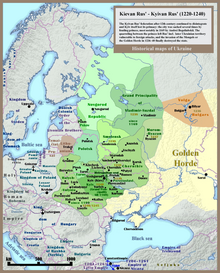
Volodimerovichi,grand princes of Kiev
- Izyaslavichi of Polotsk,princes of Polotsk
- Putyatin,princes Putyatin (extant)
- Izyaslavichi of Turov,princes of Turiv and Volhynia
- Monomakhovichi,princes of Pereyaslav
- Izyaslavichi of Volhynia,princes of Volhynia, kings of Rus (senior branch)
- Rostislavichi of Smolensk,princes of Smolensk (middle branch)
- Kropotkin,princes Kropotkin (extant)
- Lvov princely family,emerged in the 17th century as descendants of the Rostislavichiprinces of Yaroslavl(before 1260 Yaroslavl was in Yurievichi hands)
- Rzhesvsky,non-titled (extant)
- Prozorovsky(extinct since 1914)
- Yurievichi,princes of Vladimir-Suzdal; until 1260princes of Yaroslavl
- Daniilovichi,princes of Moscow.[43]This branch would reign inMuscovyand theTsardom of Russiauntil it went extinct with the 1598 death ofFeodor I,which caused theTime of Troubles.
- Konstantinovichi, princes ofGalich, Russia(1247–1362). Progenitor:Konstantin Yaroslavich,son ofYaroslav II of Vladimir
- Lyapunov family,emerged in the 16th century as descendants from the Konstantinovichi princes ofGalich, Russia
- Shakhovskoy,princes of Yaroslavl (senior extant branch)
- Lobanov-Rostovsky,princes of Rostov (middle extant branch)
- Gagarin,princes ofStarodub-on-the-Klyazma(junior extant branch)
- Khilkov,princes ofStarodub-on-the-Klyazma(junior extant branch)
- Sviatoslavichi,princes of Ryazan and Murom
- Olgovichi,princes of Chernihiv
- Skarzynski,[44][45]Belarusian nobles
- Gorchakov,princes Gorchakov (extant)
- Massalski family,princes of Mosalsky (Massalsky)
- Obolensky,princes Obolensky (extant)
- Dolgorukov,princes Dolgorukov (extant; cadet branch of the Obolensky family)
- Olgovichi,princes of Chernihiv
- Rostislavichi of Tmutarakan,princes ofTmutarakan
- Rostislavichi of Halych,princes of Halych
- Vadbosky, a branch of the princesBelozersky(extant)
- Volkonsky, a branch of the princes of Tarusa (extant)
Disputed
[edit]- Possibly theOgiński family;various "Rurikid" branches have been proposed, as well as Lithuanian ones.[citation needed]
- Possibly theOstrogski family,a branch of theRomanovichi,but could also be descended from the LithuanianGediminids.[citation needed]
- Possibly theWiśniowieckifamily, a branch of the House ofZbaraski(extinct),[46]but could also be descended from the LithuanianGediminids.[citation needed]
Legacy
[edit]RussianandUkrainianhistorians have debated for many years about the legacy of the Rurikid dynasty. The Russian view sees thePrincipality of Moscowruled by the Rurikid dynasty as the sole heir to the Kievan Rus' civilisation, this view is "resting largely on religious-ecclesiastical and historical claims" because Eastern Russian lands managed to establish themself as independent state that was ruled by the Rurikid dynasty until 16th century. This view started inMoscowas ruled by the original Rurikid dynasty between the 1330s and the late 1850s.[47]At the same time Ukrainian view of sole succession is based on continuity from the Kievan Rus and its subsequentKingdom of Ruthenia,Lithuania-Ruthenia,Cossack Ukraine.For that it had utilised mainly territorial, ethnodemographic, social, and institutional arguments.[47]
The predominant Ukrainian view had gradually changed over time. After decline of Kievan Rus rulers of Galicia-Volhynia claimed sole succession and the title of ruler of all former Rus lands as was noted inKievanand thenGalician–Volhynian Chronicles.[48]Following downfall of Galicia-Volhynia, monarchs ofGrand Duchy of Lithuania and Rutheniaand thenPolish–Lithuanian Commonwealthclaimed sole successionas well, which in turn was supported by Ruthenian population and historians at the time. But that view had shifted by mid 17th century, especially afterPereiaslav Agreementand publication ofKievan Synopsisin 1674[49]that viewed people ofGreat Russia,Little RussiaandWhite Russiaas singleAll-Russian nationunder leadership of Tsar. Though latter was challenged, but eventually became predominantly accepted untilHistory of Ruthenianswas written at the break of the 18th and 19th centuries underlying foundation for separate Ukrainian historiography with later monolineal and exclusivist Ukrainian national theory being advanced by national historiography between the 1840s and the end of the 1930s. It was summarised most clearly byMykhailo Hrushevskyin hisHistory of Ukraine-Rusʹlaying foundation for current sole succession view.
DuringSoviettimes by 1930s priorAll-Russian nationideology was a modified to "allot equal rights to the Kievan inheritance to theThree Slavic peoples,that is the Russians, the Ukrainians, and theBelorussians",but later elevated the Russian nation as the elder brother to give the others" needed guidance in revolutionary struggles and socialist construction. "[50]
There are currently various extant branches of the Rurikids, for instance: the Houses ofShakhovskoy,Gagarin, andLobanov-Rostovsky.Their representatives include Prince Dmitriy Mikhailovich Shakhovskoy (born 1934);Prince Dmitri Andreevich Gagarin(born 1934); andPrince Nikita Lobanov-Rostovsky(born 1935), a descendant of Prince Konstantin Vasilyevich ofRostov.The three of them are of theMonomakhovichibranch.[51]While the Shakhovskoys claim descent fromMstislav I of Kiev,the Gagarins and the Lobanov-Rostovskys are descendants ofVsevolod III of Vladimir,which makes the Shakhovskoys the most senior.[citation needed]
Gallery
[edit]-
Arms of the House ofHolstein-Gottorp-Romanov
-
Coat of arms of theDolgorukyfamily
-
Coat of arms of theBelosselsky-Belozersky family
-
Coat of arms of theKropotkin family
-
Gagarin family/KhilkoffCoat of arms
-
Coat of arms of theGolitsynfamily
-
Coat of arms of theGorchakovfamily
-
Coat of arms of theMosalskyfamily
-
Coat of arms of theOstrogskifamily
-
Coat of arms of theRomodanowskifamily
-
Coat of arms of theShuyskifamily
-
Coat of arms of theTatischevfamily
See also
[edit]Notes
[edit]- ^Belarusian:Рурыкавічы,romanized:Rurykavichy;Russian:Рюриковичи,romanized:Ryurikovichi,Ukrainian:Рюриковичі,romanized:Riurykovychi,lit. 'sons/scions of Rurik'.
- ^Christian Raffensperger (2012, 2017), Ostrowski (2018), Halperin (2022).[16][17]
- ^Including Hrushevsky (1904), Vernadsky (1943), Riasanovsky (1947), Paszkiewicz (1954), Franklin and Shepard (1996).[20]
- ^'Of the eighteen cases of a new ruler ascending to the throne, the [Kievan Chronicle] describes their sitting on the throne of their "grandfather and father" 15 times, 18 of their "grandfathers and fathers" twice, and of his "father and grandfathers" once.'[22]The two 5-generation lists in theKievan Chronicleincludes the 12th-centuryRurik Rostislavich,but no mention of the supposed dynasty founder Rurik, which Ostrowski (2018) found remarkable: '[TheKievan Chronicle] makes no reference, allusion, or mention in any way to the Riurik who supposedly founded the dynasty, even more telling because of the ruler who he is extolling has the same name. When a connection with Riurik could be made with the addition of just one more generational antecedent, we find no attempt to do so before the mid fifteenth century.'[23]
References
[edit]- ^abOstrowski 2018,p. 30.
- ^Rurik Dynasty (medieval Russian rulers)Archived27 March 2015 at theWayback MachineBritannica Online Encyclopedia
- ^The Oxford illustrated history of the Vikings.Oxford [England]: Oxford University Press. 1997. pp. 138–139.ISBN9780192854346.
- ^Perrie, Maureen (2006).The Cambridge History of Russia. Volume 1. From Early Rus' to 1689.Cambridge: Cambridge University Press. pp. 2, 47–48.ISBN1107639425.
- ^Maiorov, A.V."The Imperial Purple of the Galician-Volynian Princes"(PDF)(in Russian).94(47): 147–161.doi:10.17223/18572685/36/8(inactive 31 January 2024).Archived(PDF)from the original on 26 June 2022.Retrieved23 May2022.
{{cite journal}}:Cite journal requires|journal=(help)CS1 maint: DOI inactive as of January 2024 (link) - ^abBurbank, Jane; Cooper, Frederick (11 May 2021).Empires in World History: Power and the Politics of Difference.Princeton University Press. p. 190.ISBN978-1-4008-3470-9.Archivedfrom the original on 3 November 2023.Retrieved30 October2023.
The Moscow princes are often called Daniilovichi after their most prominent ancestor, Daniil, Alexander Nevskii's son
- ^Grey, Ian (1972) [1964].Ivan III and the Unification of Russia(2nd ed.). English Universities Press.ASINB004GV3YAM.
- ^May, T."Khanate of the Golden Horde".accd.edu.Archived fromthe originalon 7 June 2008.Retrieved27 December2007.
- ^Riasanovsky, Nicholas V. (29 September 2005).Russian Identities: A Historical Survey.Oxford University Press. p. 65.ISBN978-0-19-534814-9.Archivedfrom the original on 3 November 2023.Retrieved30 October2023.
- ^Kort, Michael (2008).A Brief History of Russia.New York: Infobase Publishing. pp. 26–30.ISBN9781438108292.Archivedfrom the original on 3 November 2023.Retrieved5 October2023.
- ^Payne, Robert (2002).Ivan the Terrible(1st Cooper Square Press ed.). New York: Cooper Square Press. pp. 24–25.ISBN9780815412298.
- ^HALPERIN, CHARLES J. (2014)."Ivan Iv as Autocrat (Samoderzhets)".Cahiers du Monde russe.55(3/4): 197–213.doi:10.4000/monderusse.8000.ISSN1252-6576.JSTOR24567509.Archivedfrom the original on 1 October 2023.Retrieved5 October2023.
- ^"Rurik Dynasty Lays Claim to Kremlin".The Moscow Times.16 June 2010.Archivedfrom the original on 26 November 2022.Retrieved24 October2022.
- ^Christian Raffensperger and Norman W. Ingham, "Rurik and the First Rurikids",The American Genealogist,82 (2007), 1–13, 111–119.
- ^Library, New York Public (2003).Russia Engages the World, 1453-1825.Harvard University Press - T. p. 17.ISBN978-0-674-01193-9.Archivedfrom the original on 3 November 2023.Retrieved30 October2023.
Thus the dynasty that had ruled Rus' for over 700 years-the Riurikid-ended. Boris Godunov was "elected" tsar, but his legitimacy was challenged
- ^abHalperin 2022,p. viii.
- ^Ostrowski 2018,p. 47.
- ^Ostrowski 2018,p. 39.
- ^Ostrowski 2018,p. 35.
- ^Ostrowski 2018,p. 30–31, 39.
- ^Ostrowski 2018,p. 32–34.
- ^Ostrowski 2018,p. 34.
- ^Ostrowski 2018,p. 35–36.
- ^abcOstrowski 2018,p. 30–31.
- ^Ostrowski 2018,p. 36.
- ^Ostrowski 2018,p. 31.
- ^Raffensperger 2016,p. 9.
- ^"The Vikings at home".HistoryExtra.Archivedfrom the original on 4 May 2020.Retrieved24 May2020.
- ^"Kievan Rus".World History Encyclopedia.Archivedfrom the original on 14 April 2021.Retrieved24 May2020.
- ^"The Vikings (780–1100)".metmuseum.org.Archivedfrom the original on 23 April 2020.Retrieved24 May2020.
- ^"Viking Tours Stockholm, 20 Historical Cultural Transported Tours".Sweden History Tours.Archivedfrom the original on 19 May 2020.Retrieved24 May2020.
- ^Blöndal, Sigfús (1978).The Varangians of Byzantium.Cambridge University Press. p. 1.ISBN9780521035521.Archivedfrom the original on 14 April 2023.Retrieved28 March2020.
- ^abStefan Brink, 'Who were the Vikings?', inThe Viking WorldArchived14 April 2023 at theWayback Machine,ed. by Stefan Brink and Neil Price (Abingdon: Routledge, 2008), pp. 4–10 (pp. 6–7).
- ^"Russ, adj. and n." OED Online, Oxford University Press, June 2018, oed /view/Entry/169069. Retrieved 12 January 2021.
- ^The Russian Primary Chronicle,translated by Samuel Hazzard Cross and Olgerd Sherbowitz-Wetzor, pp. 59–60. For original, seehereArchived16 September 2017 at theWayback Machine.
- ^Franklin, Simon, and Jonathan Shepherd.The Emergence of Rus 750–1200.Harlow, Essex: Longman Group, Ltd., 1996. pp. 38–39.
- ^Zhur, K. V.; Sharko, F. S.; Sedov, Vl. V.; Dobrovolskaya, M. V.; Volkov, V. G.; Maksimov, N. G.; Seslavine, A. N.; Makarov, N. A.; Prokhortchouk, E. B. (2023)."The Rurikids: The First Experience of Reconstructing the Genetic Portrait of the Ruling Family of Medieval Rus' Based on Paleogenomic Data".Acta Naturae.15(3): 50–65.doi:10.32607/actanaturae.23425.ISSN2075-8251.PMC10615192.PMID37908771.
Genome-wide data of the medieval and modern Rurikids unequivocally indicates that they belong to the N1a haplogroup of the Y chromosome...the contribution of three ancestral components to his origin: (1) the early medieval population of the east of Scandinavia from the island of Oland, (2) representatives of the steppe nomadic peoples of the Eurasian steppes of the Iron Age or the early medieval population of central Europe (steppe nomads from the territory of Hungary), and (3) the ancient East-Eurasian component....Previously, using these samples as an example, the gene flow of the peoples of Siberia (East Eurasian component) to the North and East of Europe was shown [34]. A high degree of homology in the Y chromosome of a representative of the Russian noble family and people of the early metal era led us to the hypothesis of the possible contribution of the East Eurasian gene pool to the formation of the northern European population of the early Middle Ages.
- ^Zhukovskyi, Arkadii (1 December 2009)."Encyclopedia of Ukraine".Entsykpopedychnyi Visnyk Ukrainy [The Encyclopedia Herald of Ukraine].1:14–22.doi:10.37068/evu.1.2.ISSN2707-000X.
- ^abPelenski, Jaroslaw.The Contest for the Legacy of Kievan Rus.New York: Columbia University Press, 1998. p. 4
- ^Raffensperger, Christian, and Norman W. Ingham, "Rurik and the First Rurikids",The American Genealogist,82 (2007), 1–13, 111–119.
- ^Averyanov K.Principality of Moscow under Ivan Kalita (Accession of Koloman. Acquisition of Mozhaisk). –M.,p. 36, 1994.
- ^Voronov, A. A. (2009). "Orthodox monastery in the forest".Монастыри московского кремля[Monasteries of the Moscow Kremlin] (in Russian).Saint Tikhon's Orthodox University for the Humanities.ISBN978-5-7429-0350-5.
- ^Martin 2004,p. 428.
- ^"Скаржинські".Archivedfrom the original on 19 April 2023.Retrieved6 August2023.
- ^"FamilyTreeDNA - Russian Nobility DNA Project".Archivedfrom the original on 6 August 2023.Retrieved6 August2023.
- ^Jerzy Jan Lerski; Piotr Wróbel; Richard J. Kozicki (1996).Historical Dictionary of Poland, 966–1945.Greenwood Publishing.p. 654.ISBN978-0-313-26007-0.Archivedfrom the original on 27 April 2023.Retrieved12 November2020.
- ^abPelenski, Jaroslaw Pelenski (1998).The Contest for the Legacy of Kievan Rus'Archived27 February 2022 at theWayback Machine.New York: Columbia University Press.
- ^Горовенко А. В. Меч Романа Галицкого. Князь Роман мстиславич в истории, эпосе и легендах. — Спб.: «Дмитрий Буланин», 2011. С. 154.
- ^Дмитриев М. В. Этнонациональные отношения русских и украинцев в свете новейших исследований // Вопросы истории, № 8. 2002. — С. 154—159
- ^Serhy Yekelchyk(2007),Ukraine: Birth of a Modern Nation(1st ed.), Oxford:Oxford University Press,p. 9,WikidataQ106457257
- ^Manaev, G. (8 July 2019)."Who founded Russia and ruled it before the Romanovs".Russia Beyond the Headlines.Archivedfrom the original on 14 January 2020.Retrieved29 January2020.
Bibliography
[edit]- Halperin, Charles J. (2022).The Rise and Demise of the Myth of the Rus' Land(PDF).Leeds: Arc Humanities Press. p. 107.ISBN9781802700565.Retrieved1 February2023.
- Martin, Janet (2004) [1995].Medieval Russia: 980–1584.Cambridge: Cambridge University Press.ISBN9780521368322.
- Ostrowski, Donald (2018)."Was There a Riurikid Dynasty in Early Rus'?".Canadian-American Slavic Studies.52(1): 30–49.doi:10.1163/22102396-05201009.
- Raffensperger, Christian (2016).Ties of Kinship: Genealogy and Dynastic Marriage in Kyivan Rus'.Cambridge, Massachusetts: Harvard Ukrainian Research Institute. p. 418.ISBN9781932650136.


